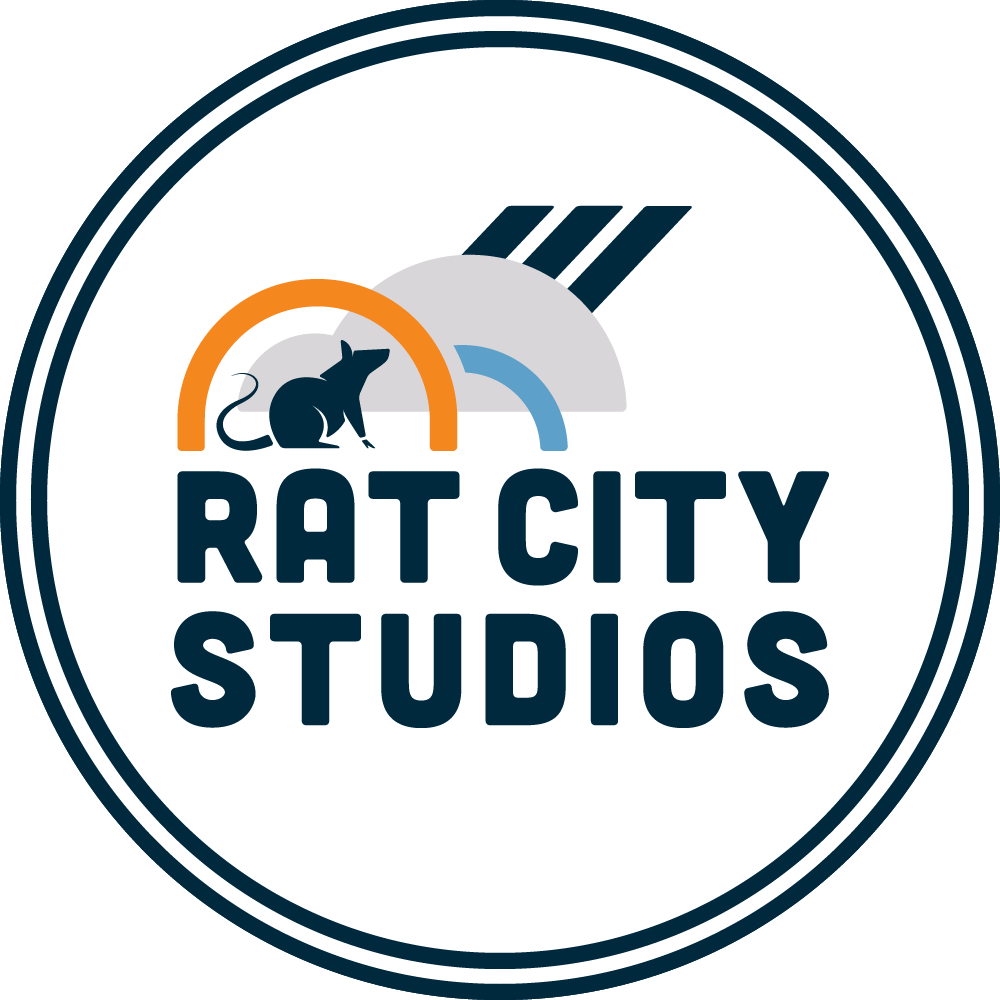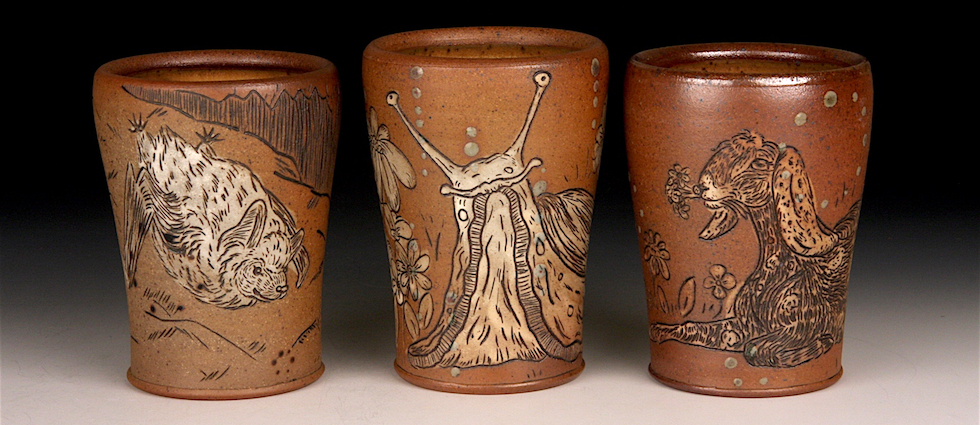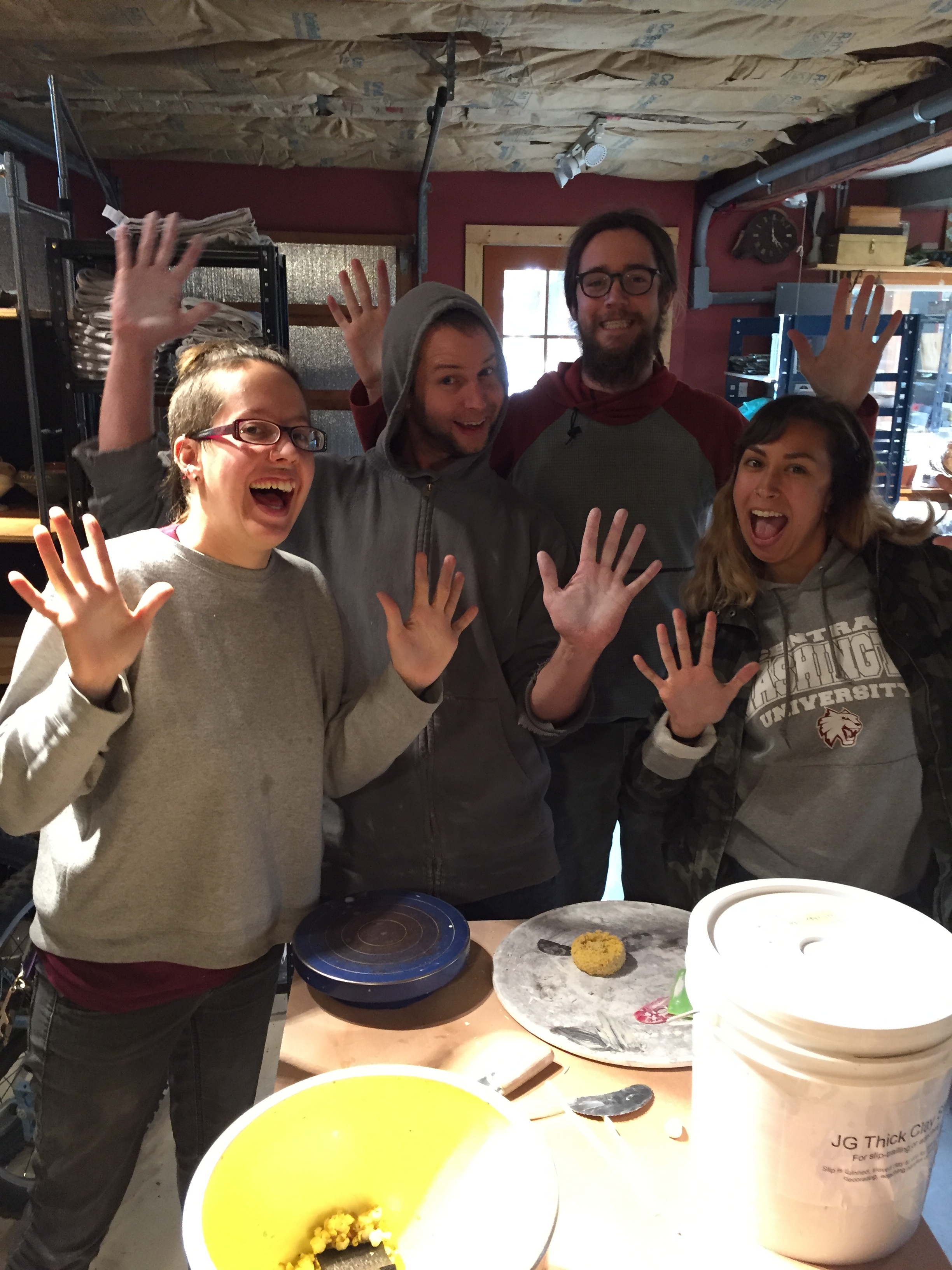Reflection on Jordan Jones’ Time as a Visiting Artist
/Written by Eliane Medina
(Website)
Jordan Jones is a potter from Whidbey Island who makes beautiful soda fired work featuring hand-drawn imagery of animals in nature. She’s an awesome person with a fun, spunky personality and is easy to talk to. She loves animals and has her own chickens, goats, cats and a dog with her on the island. Jordan is a hard worker and an inspiration to those of us working towards living a life doing what we love. Back in October, she joined us at Rat City Studios as a visiting artist for a week. She made work at the studio, spent some quality bonding time with all of us, and gave a great presentation about how she came to be a potter.
We had such a fun time with Jordan during her week at the studio! There is always so much valuable information to be shared and received amongst artists. Having her around was a great opportunity for us all to learn more about her and the work she makes. On one of Jordan’s first days here, we all had a “plaster party”. Each of us carved and made press molds to be used for paver tiles made of studio clay and glaze reclaim. Jordan made a fantastic slug tile, and one with a chicken! These are two images often seen on her pots as well.
After her time at RCS, the three of us studio assistants and Deb sent some follow-up questions to Jordan. Big thanks to her for spending time at the studio and providing some amazing answers to our questions! Here is what she had to say:
(Questions from Jake)
Q: You have not yet gone to college to get a degree in arts. Do you think you will do this at some point?
A: Yes, that is correct, I have not yet gone to college to get a degree in the arts. I went to my local community college, but did not finish my AA degree, or pursue a degree in arts or ceramics. I was attending for my general AA, and I'm grateful I puttered around there so long because I discovered my love for ceramics. Before completing my degree, I jumped right into an apprenticeship. I am currently considering going back to school, and I’d like to definitely complete that AA by taking those pesky two last classes. After that, I've been thinking of going back to school for undergrad in ceramics, and possibly going for the MFA. I’ve also been curious about taking classes in things not related to pottery, ranging from just different media like printmaking and photography, to completely out of the art realm and maybe business, accounting, or geology and astronomy. There are so many options for paths to take regarding schooling, it’s honestly a little (okay, a lot!) overwhelming. Going back to school has been on my mind for quite a while now. I know I'll get back to it, and I'm excited to find out what path I end up taking.
Q: How do you think not going to school has affected your work and how people perceive your work?
Q: How do you think going to school would change your work and how people perceive your work?
A: This is a hard, but great question. I'm going to lump them both into one. I'm not entirely sure that I can articulate how not going to school has affected my work, and I don't think I'll be able to actually know unless I go to school and see what impact that has on my work. I also think there are so many variables with going to school that it's hard to pinpoint exactly what or how I think it would change my work, unless I go and find out.
I know that I have had a limited exposure of teachers, styles of teaching, and consequently, limited familiarity with different making styles and techniques. I make soda fired work because it's what was available during my apprenticeship. I continue to make it because I continue to have access to soda kilns. Would I be making work that was fired differently if I went to a school that had more/different options? Possibly! I think that the facilities really are one of the big appeals to going back to school, I can have the freedom to experiment and learn so many different firing and making techniques. There is the possibility of so many new perspectives, and currently being on a small island, that is something that I think about frequently.
I'm also not sure I can accurately state how people perceive my work by not going to school. This one is hard because while it does come up, not everyone is asking my schooling history when they buy a pot from me. When they do, the fact that I haven't gone the traditional schooling route has never put someone off of purchasing a pot directly from me. But, I'm not sure if that is happening in galleries or online shows.
I have had a wide range of reactions to myself, instead of my work, when people find out I haven't gone the traditional schooling route. There are people that tell me that getting an MFA is the only way to be successful, and then there are people that tell me I'm crazy for even considering going back to school. School seems to be such a widely controversial topic for artists. I think I'd like to give it a shot though and see what it's all about. I've gone the apprenticeship route and I feel that going the school route afterwards will give me an interesting and well-rounded experience.
(Questions from Jon)
Q: What does a typical day in the studio look like for you?
A: A typical studio day for me really is variable! Some days are easy going, and other days are crazy 14-hour binges trying to finish things up for a firing deadline. But generally, I try to schedule it so I'm in the studio at the same time most days regardless of what needs to get done. I don't usually get into the studio until 10 or 11am, even though I get up around 7-7:30am. My early mornings are spent tending to my animals, doing house chores, and computer work. I'll break for a quick lunch sometime around 2-3pm, and go back into the studio until 5ish, which is generally animal feeding time. I'll grab dinner for myself, and depending on what needs to be done, I'll either go back to the studio or stay in for the night.
As for actual studio time break down, some days are complete throwing days, some days are full of drawing and carving, but ideally I like to try to stagger things so I have a little bit of everything going on at the same time. I like to start my days with a little throwing, and then tend to the pots from previous days. For example, in my studio I currently have dinner plates needing to be thrown, mugs ready for handles to be attached, mugs ready to be carved, and plates ready to be trimmed. I find if I’m able to rotate tasks and work in small batches of each thing, I don’t get too tired of any one task- mentally and physically. This also helps because my studio is totally a damp room during the winter months and having multiple things going keeps me from getting stuck with everything too wet to work on.
Q: What part of your process excites you the most?
A: There are a few things that are tied for giving me the most excitement in my process! When I'm struggling with a new form or shape, it is really exciting when I feel like I've "got it"- a knob that looks good, a lid that fits, a large form not collapsing...working things out is always satisfying. Getting in the swing of things and being in the zone is still exciting to me as well, I love when I lose track of time in the studio. There's also always excitement when I have a new drawing or even just drawing an old illustration "just right" and having it fit well on the pot. And honestly, firing soda kilns is still pretty exciting. Unloading them is exciting too, but I usually feel more anxious than excited. I really begin to feel excited and thrilled with my pots when I'm spending time with them after unloading, when I am sanding them smooth. This gives me a chance to really look at them and see all of their variations, and be able to feel them and see what works well, and what didn't quite make it and needs improvement. I feel so lame saying sanding is one of my favourite parts of my process, but it's true!
Q: How much does selling work factor into the things you make? Where do you find the balance between experimenting with forms and images and making that which is tried and true?
A: Selling work is a pretty big factor into what I make. I feel like I have more freedom with what I'm drawing on my pots, but I do feel that a lot of what I'm creating is based on what I need to restock galleries - mugs, bowls, cups, plates. I am making the majority of my income based on selling my pottery. That is such a great question about balance - and it's something I'm continually asking myself. Balance is hard for me, and it's an easy cycle for me to get stuck in: how do you branch out and try new things when you are busy making things that are tried and true, especially when those tried and true things are paying the bills? One thing that helps me branch out in a very small way is to take on special orders. My special orders are usually pet portraits on mugs, so they don't seem scary or hard to shift gears to, it's just another mug. But the act of sitting down to sketch something new usually spurs me to continue to be drawing new images, or gives me new ideas for imagery. It also helps me look at different ways to try surface treatment, and gives me fresh perspectives that I later try on my regular line of pots. I don't think I've figured it out how to balance those two things yet, but it is something I am aware of and trying to seek out.
(Questions from Eliane)
Q: Do you plan on doing more residencies, and how does this affect a goal for if/when you might have a studio of your own
A: I’ve actually never done a residency! Along with the line of thought of going back to school, going to a residency has also been on my mind a lot. I'd love to apply to some in the near future. That is an interesting question about if it affects when/if I might have a studio of my own, I don't think I've necessarily thought of a residency along with that. I think going to a residency would be a great in-between place of where I am now and the future studio of my very own, but I could also see myself doing a residency after I'm settled into my own studio. I honestly might be able to see myself enjoying the residency more if I knew exactly what I was coming home to - and that I did have a studio to come home to, instead of the ever-looming question of "where next?".
Q: How important is it for you to be applying to galleries/ shows in terms of making a living as a potter? How often do you try to apply to opportunities?
A: This is a great question. I make most of my income from direct sales, but gallery sales are a close second. Shows are usually not a huge money maker for me- I generally break even with shipping and jury fees, but they have gotten me gallery representation that has been very successful. So, it is hard to say exactly how important it is for me to be seeking out more galleries or shows- I feel pretty good at the moment with the amount of work I am sending out to galleries. I think I was more driven to apply when I was just starting out, but I'd like to find a little more balance before I apply to other galleries.
Q: Are you interested in teaching ceramics classes?
A: Yes, I am interested in teaching ceramics classes! This is not something I've really allowed myself a lot of time to explore, but I think I would like to make time to try this out this year. I think I would enjoy it and it would be a good way to not be alone in the studio and to help bring new perspectives in.
(Questions from Deb)
Q: How do you find discipline when you’re having an off day or working on something not exciting?
A: This is such a good question. I struggle with discipline and it is something I am always aiming to improve. I think this is one of the downsides of having a home studio - it's so easy to get frustrated, or bored and get distracted with something else. There's so much to do around the house and property it's easy to get trapped in the "house vortex" and prioritize other things over actual Work. For those off-days, I try to keep myself in the studio by setting a timer for an hour. If I can make it through the hour and I'm still having a bad time, I let myself take a break doing something else: yard work, reading a book, walk around the block, something to reset my attitude and give it another shot in the studio when I'm done. But usually, by the time the hour is up I'm wrapped up in whatever I was working on. Having something I'm dying to finish listening to helps tremendously! I save my podcasts and audiobooks as studio time-only, so it helps me stay longer than I would without them.
Q: What part of the ceramic process do you like the least?
A: This is probably the easiest question to answer - GLAZE MIXING! I really don't know why I despise it so but I do. I'll put it off until I absolutely can't. I don't like the way the triple beam hits the 0 perfectly and then rises slightly or dips just below, I hate all the dust floating around which makes me second guess how well my respirator is fitting, I loathe mixing gloppy glaze pudding, and I really dislike all of the straining.
Q: What is your favorite thing to serve on your dishes, and can we have the recipe?
A: My favorite thing to serve on my dishes is probably shortbread cookies. Absolutely you can have the recipe!
Ingredients:
- 2 cups all purpose flour
- 1/2 teaspoon salt
- 3/4 cup confectioners' sugar
- 1 teaspoon pure vanilla extract
- 1 cup (2 sticks) butter, room temperature
In a food processor, pulse together all the ingredients. Pulse together until dough is formed. Place dough on a sheet of plastic wrap, and roll into a log, about 2 1/2-inches in diameter. Tightly twist each end of wrap, and chill in refrigerator for 30 minutes.
Preheat oven to 375 degrees F.
Slice the log into 1/3-inch thick disks. Place on parchment lined baking sheets, 2 inches apart. Bake until edges are just brown, about 12 minutes. Let cool on sheets for 5 minutes, then transfer to wire racks and cool to room temperature.









